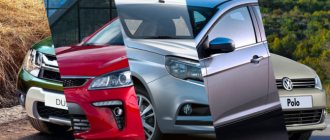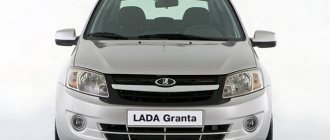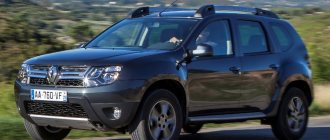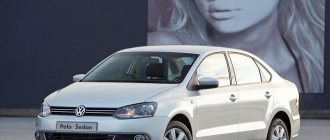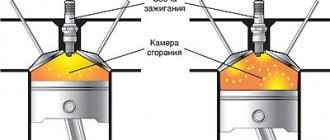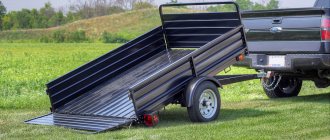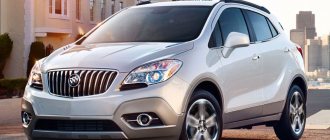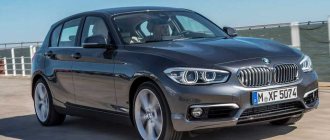From the moment the car ceased to be an outlandish design that made a lot of noise and was rarely able to overtake a horse, all private vehicles began to be divided into different types - classes. In fact, an ordinary motorist is unlikely to need information about what class his car belongs to. On the other hand, engineers and employees of major automotive publications quite actively use the established classification to compare different vehicles and evaluate their characteristics depending on the type. Today, almost all major car manufacturers offer serial and exclusive models, also dividing them into classes. In this article we will try to figure out what classes of cars exist, how business class differs from middle class, and we will dot the “I”s in this matter.
Car classes that came from Europe
It is important to understand that it is not possible to speak exactly about the time and place of the appearance of any ordered classification of vehicles. We only know that the idea of dividing cars according to certain criteria took root in Europe, after which it quite successfully spread to the rest of the world. Moreover, division remains truly important for a small number of specialists and is practically not used by ordinary car owners.
The modern classification is less technical and more market-based. It is used in assessing the place of a car in the global market. There are practically no strict boundaries between each of the categories of machines, and parameter restrictions remain more of a recommendatory tool than a canonical one. First of all, it is customary to pay attention to the appearance of the machine, dimensions, the presence of certain systems, as well as cost. It is important to understand that in one group of cars there can be literally a variety of cars that differ from each other in a number of important parameters. Moreover, they can even be produced taking into account various technologies. But this still does not prevent them from belonging to the same class. A striking example is the Nissan Almera - this is a car whose documentation states class B+. Both the cost and the level of comfort correspond to it. But, judging by the width and length of the car, it should be classified as a C-class.
The difference between “civilian” types of cars and sports ones is the lack of exact values. Simply put, if you look at auto and motorsports, the division of vehicles there is very strict and depends, first of all, on the exact technical characteristics: power and engine size, speed, height and stiffness of the suspension, weight, etc. The classification of ordinary private cars is clearly inferior in this regard to the sports version, since it does not imply any strict framework or clarification. It is impossible to say, looking at an individual passenger car, that it belongs specifically to this type - there will definitely be a specialist who, paying attention to any characteristics of the car, classifies it differently. In addition, most modern production cars are generally difficult to classify into any separate category, due to strange engineering solutions.
Today we will consider only those classes that are generally accepted and distributed throughout the world. Undoubtedly, they can hardly be applied to absolutely all private cars, but they are the ones you can most often find in reviews by journalists and documentation from manufacturers.
There are currently twenty main classes of cars. There are also several fairly extensive subclasses that can more accurately assess all the technical characteristics of a car.
Nissan Maxima V (A33)
Experienced drivers appreciate the car for its trouble-free operation. Maxima V (A33) is not considered a premium car. Few people would call this model chic.
Nissan attracts buyers with an affordable price. The machine is reliable and durable. The only drawback of the body is its tendency to rust after several years of use.
The owners of the model note that it practically does not break. Some are unhappy that in the modification, where the 2.0-liter engine comes with an automatic transmission, the car's fuel consumption increases.
The disadvantage for domestic roads will be the low ground clearance. Drivers regularly touch curbs and “scratch” potholes and bumps. You should buy a Nissan Maxima V (A33) if you don’t want to overpay for a business-class car and use it for a long time.
A-class cars
A-class is one of the most common types. The length of such cars does not reach four meters, and the width is close to one and a half meters. Most often, this type includes cars designed specifically for movement in urban environments. These can be hatchbacks with three or five doors, capable of easily occupying a narrow small parking space in the middle of a noisy metropolis. The trunk is usually very small, and the passenger seats are designed to make people feel quite comfortable.
The brightest representative of the “A” type car is Matiz, which has a small engine capacity not exceeding 1.2 liters. If you want to find a good car in this class, then you should pay attention to the Kia Picanto or Chevrolet Spark, ideal for narrow city roads, but also capable of short trips between populated areas.
Classic American business car – Cadillac CTS
The review concludes with the Cadillac CTS. Compared to other business class cars from the above list, there is no hint of sports or youth orientation. On the contrary, the severity and elegance of the sedan brings it closer to the best examples of the executive series.
The Cadillac CTS is supplied to the Russian market with three options of naturally aspirated or turbocharged petrol engines with power ranging from 240 to 649 hp. The latter figure is a record for production sedans. It allows you to reach 100 km/h in 3.7 seconds and reach 320 km/h. The power units are accompanied by an 8-speed automatic transmission, all-wheel drive or rear-wheel drive.
The safety of the driver and passengers in the event of a collision is ensured by front, side and knee airbags. Stability control, auxiliary braking, lane keeping, and radar cruise control systems will help prevent accidents.
B-class cars
Also, as in the case of the first type, class “B” cars cannot be called large. They are quite small, yet they are considered the most popular and numerous among modern passenger cars.
All cars of this variety can be used by their owners on literally any civil road, from city streets to intercity highways. Capacity ranges from four to five people, including the driver. Almost all such vehicles are budgetary, that is, they are quite cheap so that representatives of not the most affluent segments of the population could afford to buy them.
Characteristics of this type of car:
- Length no more than 4.2 meters;
- Width no more than 1.7 meters;
- The engine capacity does not exceed 1.6 liters.
If we talk about representatives, then it’s worth looking at the most popular model Volkswagen Polo or Ford Fusion. All cars that are, in one way or another, similar in their driving and overall characteristics to these models are classified into category “B”.
Asia[ | ]
Japan[ | ]
In Japan, a very simple classification has been adopted:
- Keijidosha
(light class,
kei-cars
): These cars enjoy a lot of benefits. Currently, the criteria for this class are length no more than 3.4 m, width no more than 1.48 m, height no more than 2 m and engine no more than 660 cc. Nowadays, very few cars fall into this class due to the strict limitation of engine displacement.
- Small size vehicles
, often called “5 number” based on the number of characters in the license plate prefix. Length no more than 4.7 m, width up to 1.7 m, height up to 2 m and engine no more than 2000 cm³. Vans, trucks and station wagons of this class in Japan receive numbers with a four-digit prefix. It should be noted that due to the Japanese auto industry working primarily for export, these limits are rarely observed in our time, and often even cars with a length of up to 4.7 m do not fall into this class in terms of width or engine capacity.
- Normal size vehicles
, or “3 number” (and buses and trucks of this class receive numbers starting with 1 or 2 characters, respectively), this includes vehicles longer than 4.7 m, wider than 1.7 m, higher than 2 m or with engines more than 2000 cm³. In the past, many models were produced in two versions, for the domestic market they used “cut-down” ones with a length of slightly less than 4.7 m and a width of slightly less than 1.7 m, and for export they were sold in “full-size” versions, for example, the Honda Legend. Nowadays, only van and minibus manufacturers do this.
China[ | ]
The classification was developed by the China Automotive Technology and Research Center (CATARC) - essentially closer to the Japanese one, although the class names are closer to the European one.
- Small cars
, or A0-segment: length up to 4 m (approximately corresponds to European A- and B). - Category A
(A-segment): cars with two-volume bodies with a length of 4 to 4.5 m, or with three-volume engines up to 1600 cm³. - Category B
(B-segment): cars longer than 4.5 m with engines over 1600 cm³. - Multi-Purpose Vehicles
, or MPV: more than 2 rows of seats. - Sport Utility vehicles
, or SUVs: SUVs.
C-class cars
These are already cars that are approaching the middle class in their characteristics and price indicators. If you ask to choose the best representative of this type, the first thing that comes to mind is the amazing, small and powerful Volkswagen Golf.
The category is ambiguous, since it contains both very good cars and quite bad ones in all respects. Suffice it to say that many car magazines may classify cars as “C” that are more suitable for group “B”. There is also the other side of the coin, when cars from the lower classes, for some reason, the manufacturers themselves (apparently in order to popularize the model) consider them to be C-class. Statistics say that almost one third of all European motorists today own personal vehicles of this category.
Characteristics of class "C":
- The length of the car does not exceed 4.3 meters;
- The width of the car does not exceed 1.8 meters;
- Engine volume is not less than 1.6 liters, but not more than 2.0.
Volkswagen
And finally, the German – the Volkswagen Passat CC business class sedan. The minimum available engine is a 1.8-liter gasoline engine with 152 horsepower. The base gearbox is a 6-speed manual. Drive – front. Trunk volume – 532 liters. Ground clearance - 154 millimeters. The following are already installed as standard: 2-zone climate control, stabilization system, multimedia system, heated seats and windshield, rotating bi-xenon headlights, front and rear parking sensors. Price – from 1,700,000 rubles.
D-class cars
Here they are – representatives of the “middle” class of modern cars. Simply put, these are exactly the cars that experts and motorists recognize as the most convenient, comfortable and safe for transporting both passengers and various cargoes. To understand what we mean, look at the Volkswagen Passat - this is one of the best representatives of the middle class, which is mass-produced. It is worth noting that such cars perform well on almost any road. Many of the models perform well even in off-road conditions. The interior is made of natural materials, and the cost is slightly higher than that of the previous group.
How to choose a premium car
How to determine the environmental class of a car
Sales statistics show that most drivers who exchange their middle-class cars for premium ones still intuitively strive to save money. The leaders in the number of purchases are the most affordable models that “open” the segment
It turns out that for some car enthusiasts, one name with a hint of elitism is enough to feel like an important person. Recently, the number of purchases in this class has been falling due to the financial crisis.
More and more drivers prefer middle or economy class models.
A test drive is usually arranged at the dealer's showroom. Premium cars usually have a more affordable test drive. Managers immediately show the potential buyer the highest level of approach to the client, trying to sell the car right away. Once behind the wheel, the driver will quickly prioritize one model or another, assessing comfort, interior and exterior design, driving performance and functionality in the field. By comparing it with his ideas about the price, he will be able to make the right decision.
E-class cars
If you want to choose the best representative of the middle class car, then the group classified as “E” is suitable for you. True, here you can often find the name “business class”, which is due to the wide distribution of these convenient, powerful and safe cars among owners of various types of businesses. Those same Mercedes “E-shki”, which have been especially popular in the post-Soviet space since the collapse of the USSR, are the best representative of the category.
Why are they better than others? Unlike previous types, “E” is characterized, and often required, by the presence of expensive optional functions in the basic set. We are talking about excellent soundproofing materials, expensive air conditioning, and various electronic systems. In general, comfort is increased as much as possible for a mass-produced car. Such cars should be driven by a person who loves convenience and can afford it.
Characteristics of group “E”:
- Maximum length – 4.6 meters;
- Maximum width may vary depending on model;
- Engine capacity usually does not exceed 2.4 liters in the basic configuration;
- The price is an order of magnitude higher than that of the D-class.
Toyota
Now Japanese – Toyota Camry. The base for this business class sedan is a 2-liter, 4-cylinder, naturally aspirated, gasoline engine with a capacity of 150 horsepower. The base already offers a 6-band classic automatic. Drive – front. Trunk volume – 506 liters. Ground clearance – 160 millimeters. The standard equipment of the Toyota Camry includes: an audio system, full power accessories, 6 airbags, a stabilization system, 2-zone climate control, front and rear parking sensors. Price – from 1,370,000 rubles.
F-class cars
Unlike all the categories we described above, this is a special type of modern machine. What distinguishes them from others is that they are very powerful and extremely expensive. But that's not all. This type of car is considered exclusive, since not everyone can purchase such a vehicle for personal use.
"F" is divided into two main subgroups. First, the F-1 is a very expensive car, mass-produced by manufacturers. But the cost is very high due to increased conditions of comfort, safety and high technical performance. There is also a subgroup F-2 - this is an even more expensive transport, since each model is assembled by hand. Few people can afford such a car. This is already more of a status thing than just a means to drive around Europe during vacation or stand in traffic jams on the way to the office.
Group K cars
This category consists of powerful SUVs of various models and types. Within the group, there are as many as four subgroups, each of which differs from the other in size and technical characteristics of the machines included in it.
- The K-1 type includes not very powerful and fairly light 4x4 SUVs. They are ideal for short trips off the highway and feel quite good in urban conditions.
- The best solution for provincial roads;
- Type K-2 – mid-size SUVs. They can be called the most adapted to any conditions, since such cars can drive off-road with a breeze, and in a cramped city they will not cause you any inconvenience;
- Subgroup K-3. The heaviest and most powerful type of SUV. Serve as private all-terrain vehicles capable of overcoming literally any obstacles;
- K-4 are pickups that are not very common here, but very popular in the USA and Australia.
How to find out which class your car belongs to
Despite the fact that the classification of cars has no practical application yet, many motorists want to determine which group of cars their “iron horse” should belong to. To do this, you can use the data that we provided you above in the article, but accurately determining the class is not an easy task.
It should be mentioned that all over the world, regardless of the standard classification, there is its own division of passenger cars into various groups. Thus, some domestic automakers are inheriting the old system used in the USSR. Among other things, the following classifications of passenger cars are actively used in the world:
- EuroNCAP is a system of the organization of the same name, which conducts safety tests of new cars before they enter the world market. The parameters that are taken into account can be very different, from body type to vehicle weight;
- The Spanish system takes into account the taxable engine volume, based on which the ratio of individual cars to different class groups is determined;
- In the United States of America, a special classification is used. The main criterion is the working volume of the car interior, from “mini” to “full size”;
- The Japanese classification implies only three groups of passenger cars: light, medium and standard;
- China also has its own car classes. The very first is “Small”, followed by “A” and “B” classes, then cars with three or more rows of seats. The table is completed by the SUV class.
To know for sure what type your car is, you should carefully understand its documentation and accurately determine all its technical characteristics, one way or another related to the generally accepted classification. You need to know the exact length and width of the machine, take into account weight, engine power, capacity, etc. Only after this will you be able to associate your vehicle with one of the classes. But this will not be an exact definition, since the modern classification has a number of “floating” parameters that specialists can operate at will.
Honda Accord
A model with more than forty years of history cannot but be included in our rating. Since 2020, the company has been offering the tenth generation of E-class sedans according to the classification adopted in the Old World. If the previous generation had an aggressive exterior with a clear sporty bent, then the current generation looks much calmer, more balanced, but no less dynamic. Having received a memorable appearance and an updated range of more powerful power units, the car claims to regain lost positions in its class. Two gasoline engines (2.4-liter 180-horsepower and 3.5-liter 281 hp) are combined with a manual or automatic transmission and allow a speed of 210-230 km/h with an average consumption of 8.2-9. 4 l/100 km.
Honda Accord
Unfortunately, intentions to supply the car to Russia are still unknown. At the moment, you can only purchase a sedan abroad for an amount similar to 1.3-2.3 million rubles. Among the innovations, it is worth noting the innovative projection screen and heated rear row of seats. The car is comfortable, but many experts consider its cost to be slightly overpriced.

